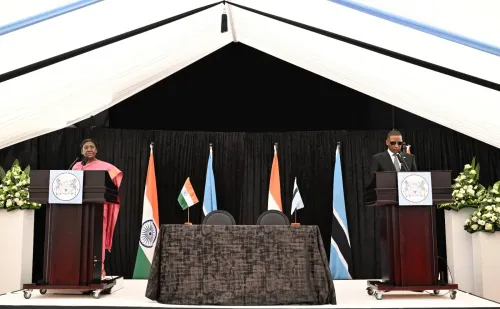Can Sustainable Cooling Reduce Emissions and Save Trillions?

Synopsis
Key Takeaways
- Sustainable cooling can drastically reduce greenhouse gas emissions.
- Implementing a Sustainable Cooling Pathway could save $17 trillion in energy costs.
- Access to cooling is essential for public health and well-being.
- Passive and low-energy solutions make up two-thirds of potential emission cuts.
- Innovative strategies can enhance cooling access for vulnerable groups.
Belem, Nov 11 (NationPress) As heatwaves intensify and the demand for cooling skyrockets, the implementation of sustainable cooling practices—especially those emphasizing passive techniques, low-energy systems, and hybrid cooling methods that incorporate fans and air conditioners with minimal or zero energy consumption—could significantly reduce greenhouse gas emissions, generate trillions of dollars in savings, and broaden access to essential cooling for vulnerable populations, according to a recent report from the UN Environment Programme (UNEP).
Launched during COP-30 in Belem, Brazil, the report titled Global Cooling Watch 2025 reveals that if current trends continue, the demand for cooling could more than triple by 2050. This surge is attributed to a growing population, increasing wealth, and more frequent extreme heat events, coupled with low-income households gaining access to more polluting and inefficient cooling options.
The forecast suggests that cooling-related greenhouse gas emissions could almost double compared to 2022 levels, reaching an estimated 7.2 billion tons of CO2 emissions by 2050. This projection persists despite ongoing efforts to enhance energy efficiency, phase out climate-harming refrigerants, and mitigate the burden on power grids during peak usage periods.
The report advocates for a 'Sustainable Cooling Pathway', which has the potential to cut emissions by 64 percent—translating to a reduction of 2.6 billion tons of CO2 emissions compared to 2050 projections.
When paired with rapid decarbonization in the global power sector, remaining cooling emissions could decrease by as much as 97 percent below business-as-usual scenarios.
Inger Andersen, the Executive Director of UNEP, stated, 'As deadly heat waves become more frequent and severe, access to cooling should be regarded as essential infrastructure, comparable to water, energy, and sanitation.'
She emphasized that we cannot solely rely on air conditioning to tackle the heat crisis, as this would only elevate greenhouse gas emissions and increase costs. Energy-efficient, passive, and nature-based solutions must play a role in meeting our escalating cooling needs while safeguarding people, food security, and economies as we strive toward global climate objectives. We have no excuses; it is now time to overcome the heat.'
The report, published by the UNEP-led Cool Coalition, is the most thorough examination to date of the rapidly escalating demand for cooling worldwide and the urgent need for climate-friendly solutions.
Through a Sustainable Cooling Pathway, access to space cooling or refrigeration, resilient infrastructure, and urban green spaces can be extended to all, including low-income and vulnerable groups such as smallholder farmers, women, and the elderly—without worsening the climate crisis.
This pathway integrates passive cooling methods, low-energy solutions, hybrid cooling systems, rapid adoption of high-efficiency equipment, and expedited phase-out of hydrofluorocarbon refrigerants as outlined in the Kigali Amendment.
Nearly two-thirds of potential emissions reductions can be achieved through passive and low-energy solutions, highlighting the critical need to incorporate them into national policies and urban planning.
Such measures are not only highly cost-effective but also vital for increasing access to cooling for an additional three billion individuals by 2050.
If implemented, this pathway could yield $17 trillion in cumulative energy savings through 2050 and avert up to $26 trillion in grid investments due to decreased electricity demand.









